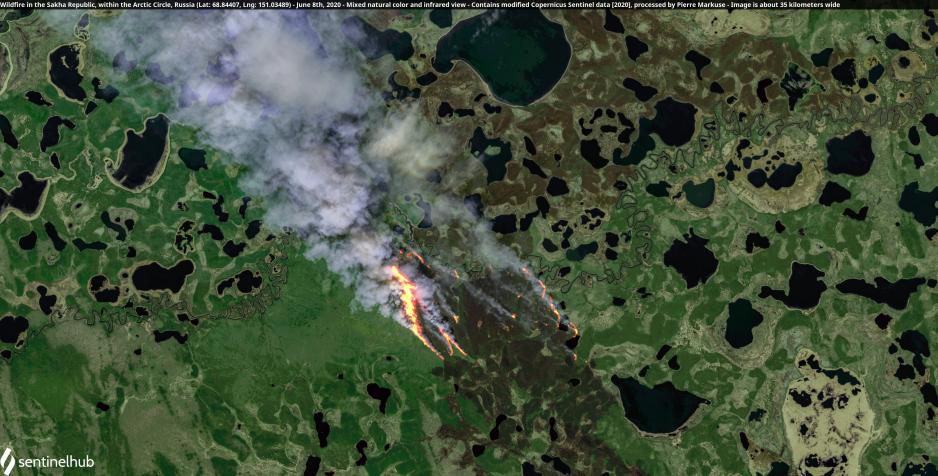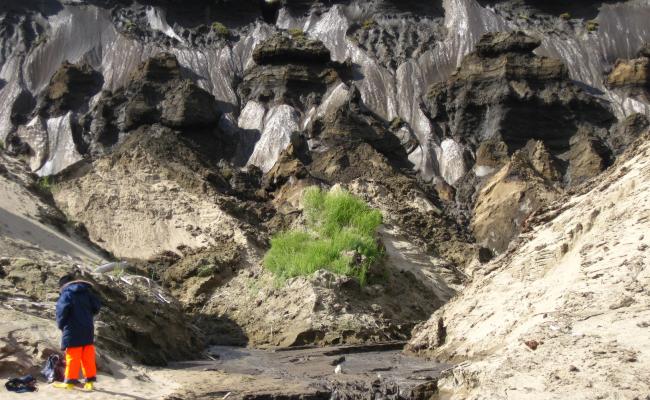Arctic Societies Must Plan for and Adapt to Increasing Occurrences of Forest Fires, Says Researcher

Wildfire in the Sakha Republic, within the Arctic Circle, Russia. June 8th, 2020. The image is about 35 kilometers wide. (Photo: Pierre Markuse)
Arctic forest fires are releasing record levels of carbon dioxide this year. "Increasing wildfire activity is one of many risks that a changing climate poses for Arctic societies", says Senior Researcher Marianne Tronstad Lund at CICERO.
In July, there was an increasing number of forest fires taking place in the High North. Among the hardest-hit places are in Siberia in Russia, especially the Sakha Republic, parts of Canada, and the west coast of the United States. Emissions contributing to global warming have totaled more than 505 megatonnes of carbon dioxide equivalents, according to estimates by the EU’s Copernicus Atmosphere Monitoring Service.
Senior Researcher Marianne Tronstad Lund at the Center for International Climate Research (CICERO) says research shows that climate change has contributed to more of the weather conditions on which forest fires depend, thus increasing the probability of forest fires.
"Weather conditions are a crucial factor for forest fires. The risk of a forest fire starting and becoming extensive increases when there are longer periods of high temperatures, low rainfall and humidity, and high winds. In many places, even in high northern latitudes, such hot and dry periods occur more often and are more intense than before, and this contributes to increasing the number of forest fires. In addition, the season for forest fires has extended in many places, so that more fires can occur throughout the year. Research shows that climate change has contributed to our getting more of the weather conditions on which forest fires depend and thus increasing the probability of forest fires".
Major consequences for nature and society
Lund says that forest fires are a natural, and necessary, part of the terrestrial ecosystem. But forest fires can also have major consequences for nature and society.
"When they hit inhabited areas, they can take lives and destroy property. Lately, we have seen examples of entire small towns being burned down and many people having to be evacuated. Forest fires also cause large emissions of both CO2 and pollution. The latter causes poor air quality and health problems for those who live in the areas."
The size of several hundred thousand football fields
The individual forest fires vary greatly in size, but the largest ones can burn more than tens of thousands of square kilometers, says Lund.
"For example, the Canadian Interagency Forest Fire Center (CIFFC) reports that forest fires in Canada as a whole have burned moret han 2.5 million hectares, or 25,000 km2, so far in 2021. By comparison, a football field is about 0.007 km2, so we are talking about several hundred thousand football fields here."
This risk may become more severe in the years and decades to come
How can we reduce this threat?
"At the overall level, it is important that we manage to limit global warming in order to limit the increase in heatwaves and droughts. Many forest fires occur due to human use of fire. Building awareness around this is therefore still important. In addition, land management and forest management are important to limit the extent of forest fires when they occur", says Lund and adds:
"Increasing wildfire activity is one of many risks that a changing climate poses for Arctic societies. With the Arctic region warming faster than the global average, this risk may become more severe in the years and decades to come. Preparing for and adapting to the consequences of increased wildfire risk is, therefore, an important part of increasing the resilience of Arctic societies in the face of climate change".




